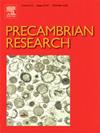2.08 Ga andesitic gneisses in the southwestern Yangtze Block: Unveiling new insights into its geological evolution
IF 3.2
2区 地球科学
Q2 GEOSCIENCES, MULTIDISCIPLINARY
引用次数: 0
Abstract
The early geological history of the Yangtze Block has been difficult to unravel due to limited exposure of Archean to Paleoproterozoic rocks. Through detailed geological investigations and mapping in the southwestern (SW) Yangtze Block, this study identified Paleoproterozoic andesitic and granitic gneisses, as well as associated sedimentary rocks, within the Xinanchang (XAC) Complex. Zircon U-Pb dating yields a concordant age of 2078 ± 11 Ma for the andesitic gneiss, and a weighted mean 207Pb/206Pb age of 1835 ± 12 Ma for the granitic gneiss. The zircon grains from these gneisses exhibit oscillatory zoning and Th/U ratios of 0.40–0.94, corroborating their magmatic origins. Additionally, U-Pb age spectra of concordant zircon grains from the XAC strata range from 1.80 to 2.69 Ga. Together with the intrusive relationship between the 1.84 Ga granitic gneiss and the strata, this implies a depositional age of ca. 1.84 Ga for the XAC strata. The andesitic gneiss exhibits enrichment in large-ion lithophile elements (LILEs) and light rare earth elements (LREEs), but shows depletion in Nb, Ta, and Ti. These geochemical signatures are consistent with those of contemporaneous andesitic magmatic rocks in the northern Yangtze Block, suggesting that they were derived from subduction-related sources. In contrast, the granitic gneiss in the XAC Complex shows A-type granite affinities, similar to contemporaneous granitoids widely found across the Yangtze Block. This indicates that these granitoids were formed in a post-orogenic extensional tectonic setting. The northern and SW Yangtze blocks both show records of a transition from subduction to post-orogenic extensional environments between 2.10 Ga and 1.85 Ga, suggesting that the proto-Yangtze Block likely aggregated before 2.10 Ga.
扬子地块西南部2.08 Ga安山岩片麻岩:揭示其地质演化新认识
由于太古宙和古元古代岩石的暴露有限,扬子地块的早期地质历史一直难以解开。通过对扬子地块西南部的详细地质调查和填图,在新安昌杂岩中发现了古元古代安山岩和花岗质片麻岩及其伴生沉积岩。锆石U-Pb定年结果表明,安山岩片麻岩的年龄为2078±11 Ma,花岗质片麻岩的207Pb/206Pb加权平均年龄为1835±12 Ma。这些片麻岩的锆石颗粒呈现振荡分带,Th/U比值为0.40 ~ 0.94,证实了它们的岩浆成因。XAC地层和谐锆石U-Pb年龄谱在1.80 ~ 2.69 Ga之间。结合1.84 Ga花岗质片麻岩与地层的侵入关系,推测XAC地层的沉积年龄约为1.84 Ga。安山岩片麻岩中大离子亲石元素(LILEs)和轻稀土元素(lree)富集,而Nb、Ta、Ti富集。这些地球化学特征与北扬子地块同时期安山岩岩浆岩的地球化学特征一致,表明它们的来源与俯冲有关。XAC杂岩的花岗质片麻岩具有a型花岗岩亲和性,与扬子地块广泛发现的同生花岗质相似。这表明这些花岗岩类形成于造山后伸展构造环境。北扬子地块和西南扬子地块在2.10 Ga ~ 1.85 Ga之间均有俯冲向造山后伸展环境过渡的记录,表明原扬子地块可能在2.10 Ga之前聚集。
本文章由计算机程序翻译,如有差异,请以英文原文为准。
求助全文
约1分钟内获得全文
求助全文
来源期刊

Precambrian Research
地学-地球科学综合
CiteScore
7.20
自引率
28.90%
发文量
325
审稿时长
12 months
期刊介绍:
Precambrian Research publishes studies on all aspects of the early stages of the composition, structure and evolution of the Earth and its planetary neighbours. With a focus on process-oriented and comparative studies, it covers, but is not restricted to, subjects such as:
(1) Chemical, biological, biochemical and cosmochemical evolution; the origin of life; the evolution of the oceans and atmosphere; the early fossil record; palaeobiology;
(2) Geochronology and isotope and elemental geochemistry;
(3) Precambrian mineral deposits;
(4) Geophysical aspects of the early Earth and Precambrian terrains;
(5) Nature, formation and evolution of the Precambrian lithosphere and mantle including magmatic, depositional, metamorphic and tectonic processes.
In addition, the editors particularly welcome integrated process-oriented studies that involve a combination of the above fields and comparative studies that demonstrate the effect of Precambrian evolution on Phanerozoic earth system processes.
Regional and localised studies of Precambrian phenomena are considered appropriate only when the detail and quality allow illustration of a wider process, or when significant gaps in basic knowledge of a particular area can be filled.
 求助内容:
求助内容: 应助结果提醒方式:
应助结果提醒方式:


